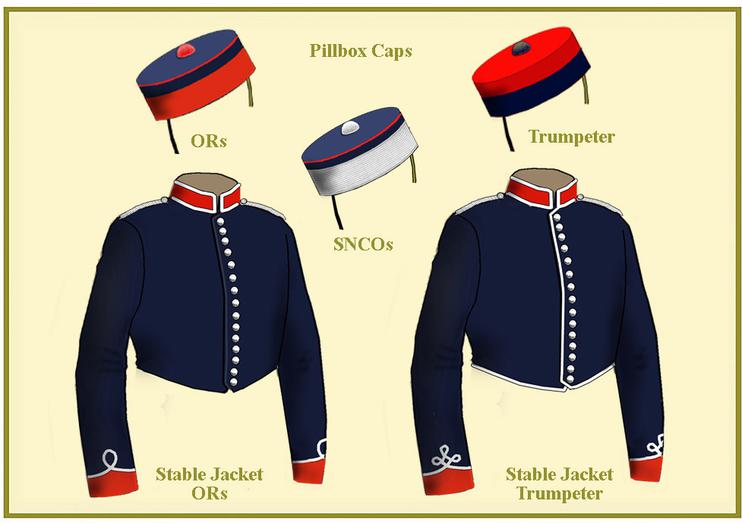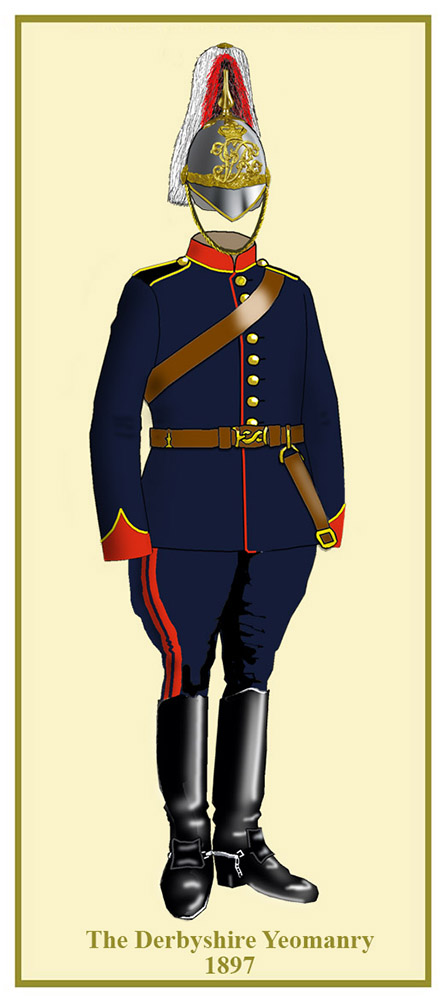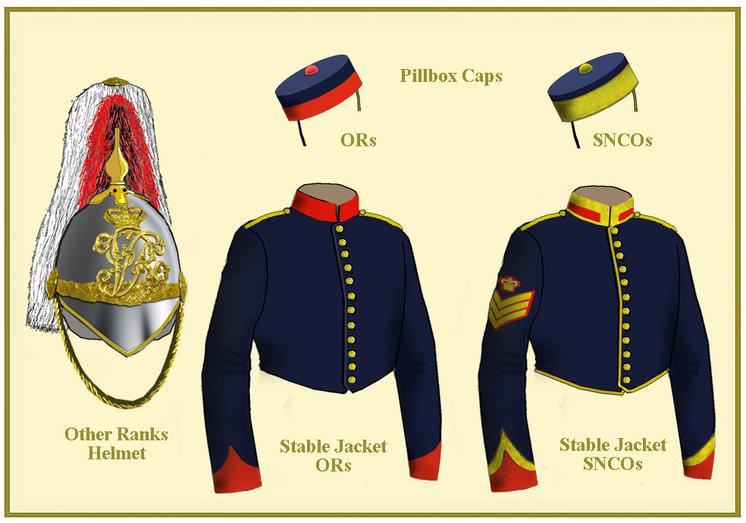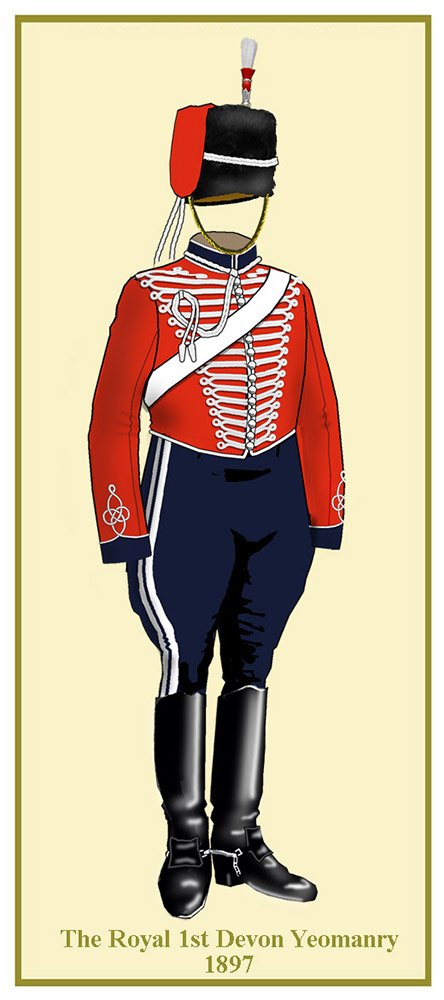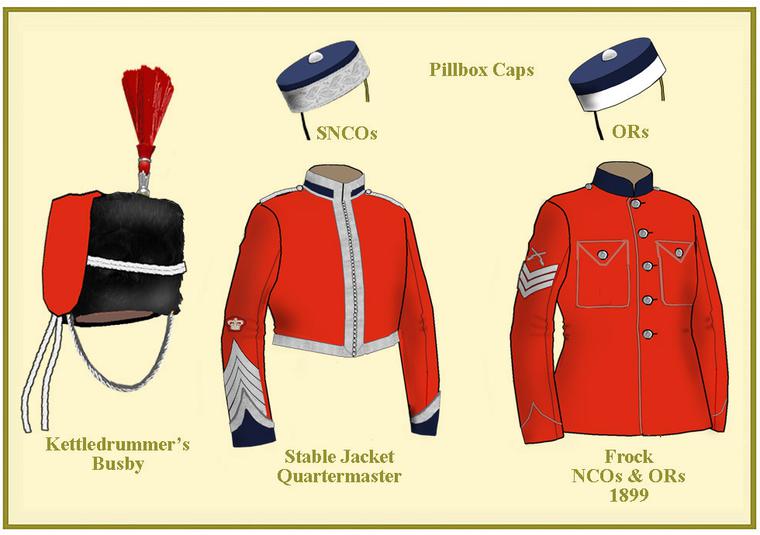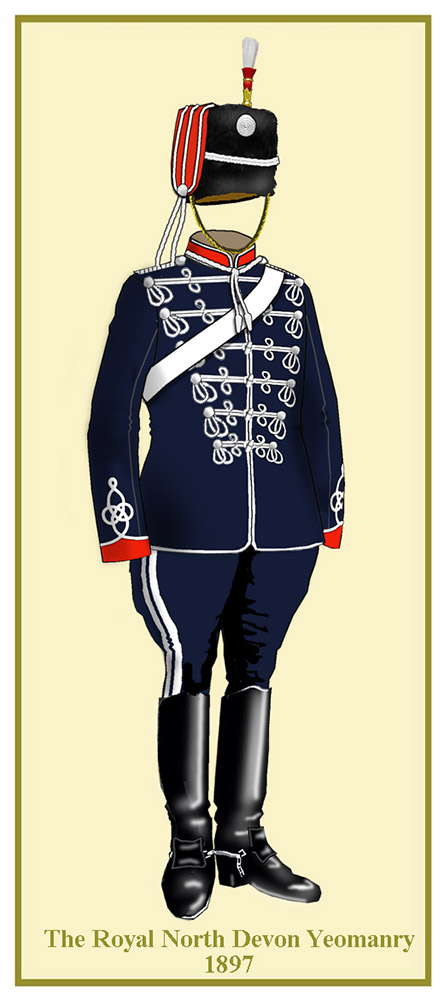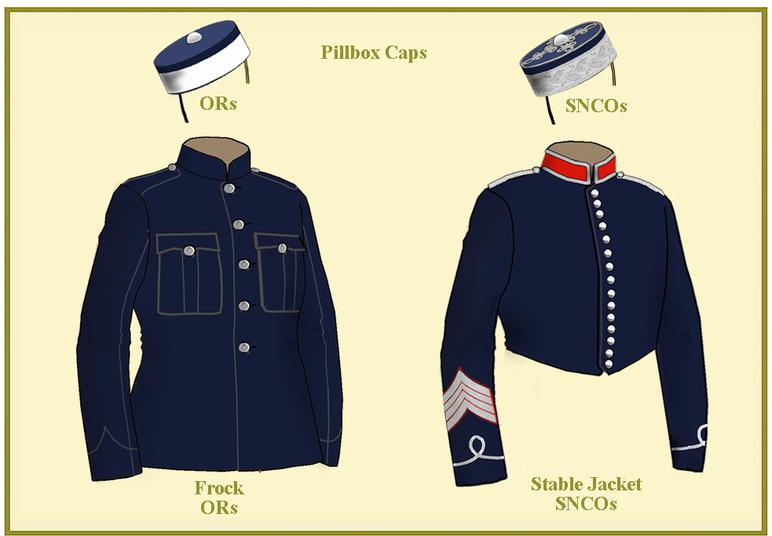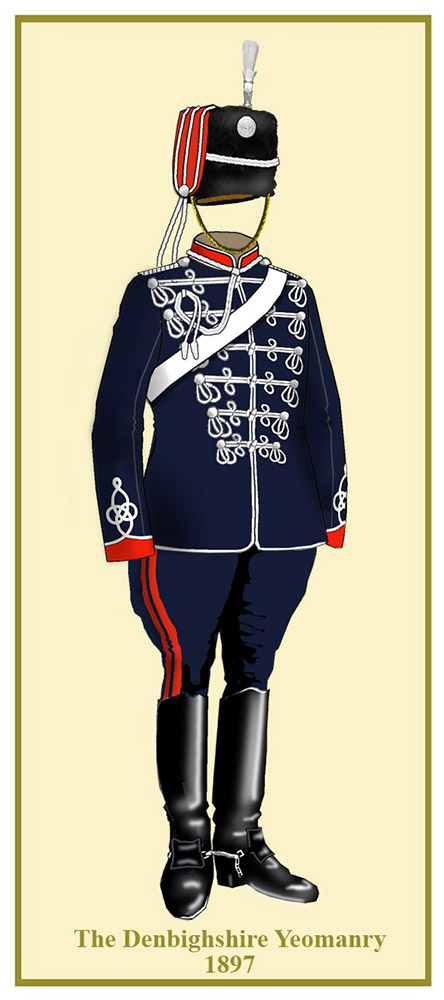The Denbighshire Hussars
Ranked No. 16 in Yeomanry Order of preference
Formed as Wrexham Yeomanry Cavalry Troop in 1795 becoming three troops in 1803. In 1820 became Denbighshire Yeomanry Cavalry consisting of five troops. 1820s and 30s spent dealing with civil unrest at the collieries. The Regiment became the Denbighshire Hussars in 1876.
Formed 29th Sqn of 9th Bn Imperial Yeomanry in 1900
UNIFORMS OF THE BRITISH YEOMANRY REGIMENTS 1895-1900
Uniform
The Denbighshire Yeomanry wore blue jackets with three vertical rows of silver buttons from the very start. At first there may have been loops across the front but by 1820 they had gone. The Tarleton helmet was worn from 1795 and a black japanned Romanesque helmet with bearskin crest was being worn in 1831. In 1840 the crest was replaced by a red flowing plume.
In 1856, the regiment adopted a hussar uniform with six loops. At the same time a black dragoon helmet with scarlet plume was taken into wear. Hussar busbies replaced the helmet in 1862. By 1895 the regiment had been issued with the current pattern busby. The uniform was the conventional hussar uniform with six loops of white frogging across the front. Collar and cuffs were scarlet and the trouser stripes were also scarlet. The busby bag was scarlet and the plume was all white. In undress troopers wore a plain stable jacket with scarlet collar and cuffs with white lacing. The blue pillbox had a white band. NCOs had silver bands. Trumpeters had trefoils on the cuffs and white piping on the jacket and on the rear seams. The pillboxes were red with blue bands. A mounted band was in existence from 1853 to 1902. Details of a special uniform are unknown. In 1902 They had gone into a khaki lancer tunic with scarlet facings and slouch hats.
The Derbyshire Yeomanry
Ranked No. 22 in Yeomanry Order of preference
Derbyshire Corps of Fencible Cavalry raised in 1794, as a regiment of full-time troops for home defence. In 1803 became the Derbyshire Corps of Yeomanry Cavalry. By 1828 only Radbourne troop remained serving without pay until 1830. In 1864 became Derbyshire Yeomanry Cavalry of 3 troops.
Formed 8th coy of 4th Bn Imperial Yeomanry from 1900 to 1902
Uniform
The A blue light dragoon uniform with black round hat and bearskin crest appears to have been worn when the regiment was raised. All the different troops wore their own uniforms which were all similar with bell topped shakos and blue jackets with silver or gold lace. There is little definitive information on uniforms until after the Crimean War. In about 1858 a white metal Albert pattern dragoon helmet was adopted with a white over red hanging plume and a short white brush above the plume holder. The badge was a large “VR” cypher in brass. The regiment was dressed as dragoons with a blue tunic and trousers with red facings and thin gold lace edging to collar and cuffs. This uniform went unchanged until the end of the century. The rank and file of the regiment had brown leather pouch belts and sword belts. One presumes the pouch was also of brown leather. Stable jackets were blue with scarlet collar and cuffs and the pillbox was blue with scarlet band and button. NCOs had gold bands. Senior NCOs had gold lace on collar and cuffs and edging to the jacket. A folding field cap with scarlet body and blue flaps with gold edging was worn by NCOs in the late 1890s. A band was also formed in the early 1890s but apparently did not wear a special uniform. Plain khaki uniforms were worn before 1908 when blue patrols were adopted with scarlet gorget patches on the collar. Scarlet staff pattern caps were worn.
The Royal 1st Devon Yeomanry
Ranked No. 28 in Yeomanry Order of preference
The 1st Devon Troop formed 1794 and becoming 1st Devonshire Yeomanry Cavalry in 1803.[2] Despite many corps being disbanded in 1828, the regiment served without pay. Became Royal 1st Devonshire Yeomanry Cavalry in 1871 with Headquarters at Exeter. In 1893, the troops were reorganised in squadrons.[2]
Formed 26th coy of 7th Bn Imperial Yeomanry in 1900
Uniform
Scarlet jackets were always a distinction of the 1st Royal Devon. The first was worn with a Tarleton helmet but the shako was adopted in 1816. Little is known about the uniforms until about 1830 when the bell topped shako was said to have gold lace and tassels. An 1840 painting shows a trooper with scarlet jacket and tall black shako with gold fittings with black drooping plume and a trumpeter in light blue jacket and pelisse with scarlet drooping plume. By 1845 the regiment was dressed as hussars with white laced scarlet jackets and Albert pattern shakos. However, in 1852 the regiment was wearing unique black felt helmets with white and red plumes. The long front and rear peaks were leather. The badge and fittings were white metal.
Hussar busbies were taken into wear in 1871 and breeches and knee boots in 1886. The later pattern busby was adopted in 1893 and it continued to be without the front white cord boss and lacing on the busby bag.
Undress stable jackets followed the regular pattern and senior NCOs had the same lacing as officers. In 1899 scarlet frocks were issued which had blue collars. After the Boer War khaki tunics were worn often with the pillbox cap. In 1908 for parade dress the regiment adopted scarlet patrols with shoulder chains. The collar and pointed cuffs were blue. The staff pattern cap was blue with a scarlet welt round the crown and scarlet welts above and below the blue band. A mounted band existed from 1870 but there is no photographic evidence of it being mounted after that date. The kettledrummer had a tall scarlet plume on his busby.
.
The Royal North Devon Hussars
Ranked No. 30 in Yeomanry Order of preference
Raised in 1798 as independent troops it was regimented as the North Devonshire Mounted Rifles in 1803. Organised by the same man that raised the 1st Devon Corps, Col. John Rolle, (1st Baron Rolle) it remained in service past 1828. In 1856 was renamed as the North Devonshire Regiment of Yeomanry Cavalry and in 1868 it became Hussars with Headquarters at Barnstaple.
Formed 17th coy of 6th Bn Imperial Yeomanry in 1900 (with Lanarkshire Yeomanry)
Uniform
The regiment was dressed conventionally as light dragoons from the time they were raised. The blue jacket with white or silver chest braid was worn with the the Tarleton helmet. This was replaced with the bell topped shako in 1819 while the jacket remained the same losing some of the ornamentation in the eighteen thirties.
In 1853 the then commanding officer applied to the War Office for mounted rifles status for the regiment which was accepted. However, this had little affect on the uniform especially when they adopted a tall cylindrical shako in scarlet with white and red caplines and a black falling plume. When they became hussars in 1868 they took the current hussar uniform into wear. The blue tunic had had six white loops across the front with scarlet collar and cuffs. The busby had a white out of scarlet plume. After adoption of the later pattern busby in 1891, the caplines were not looped across the chest but shortened and hanging in front. After 1908 these caplines were plaited and looped across the chest in 11th Hussars style. Stable jackets followed the conventional style with white (silver for NCOs) single loops on the cuffs and bottom of the collar. Pillboxes had white/silver bands and plain blue frocks were introduced in 1899. After the Boer War the regiment went into khaki with red facings and in 1908 with blue patrols and staff pattern cap. The regiment had a band in the eighteen forties and were presented with drum banners at the same time. in the eighteen fifties the band wore scarlet jackets. After converting to hussars there appear to have been no special distinctions for the band.
PART 2
YEOMANRY-09.html
Denbighshire Hussars
Derbyshire Yeomanry
Royal 1st Devon Yeomanry
Royal North Devon Yeomanry
YEOMANRY-09.html



